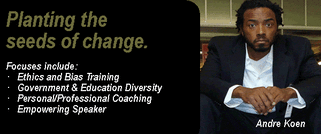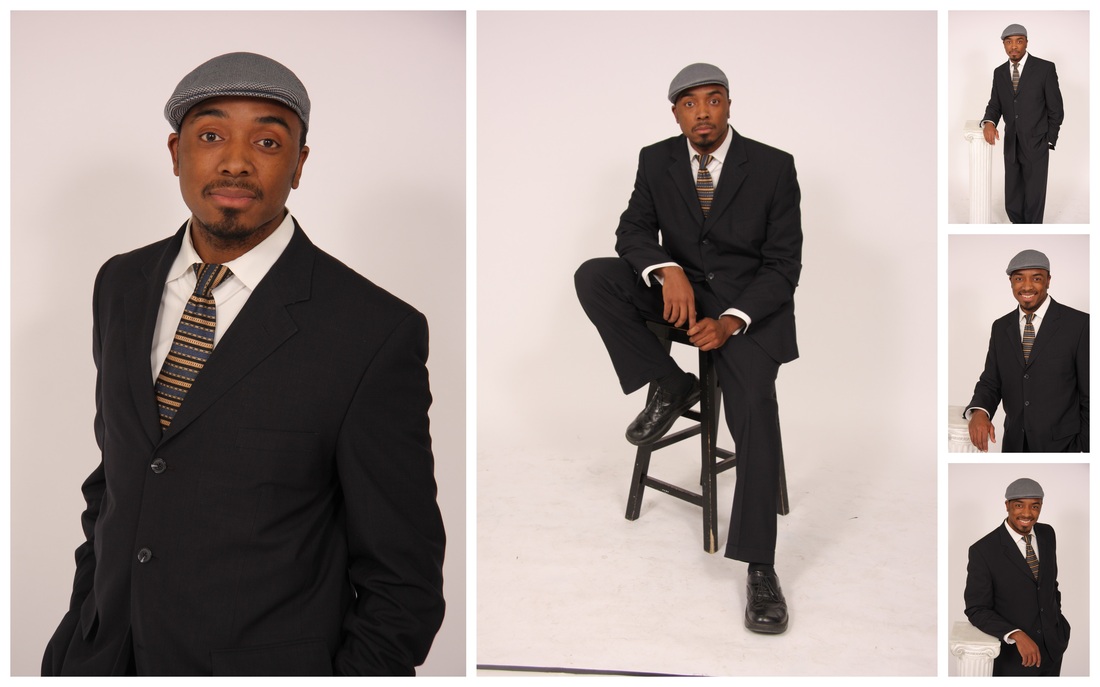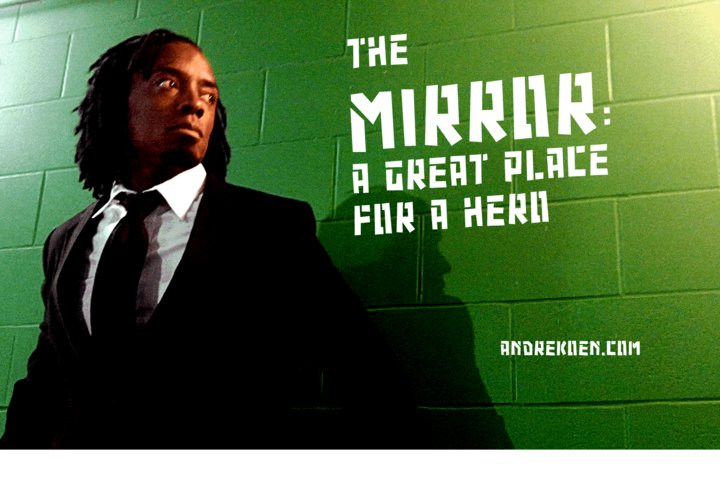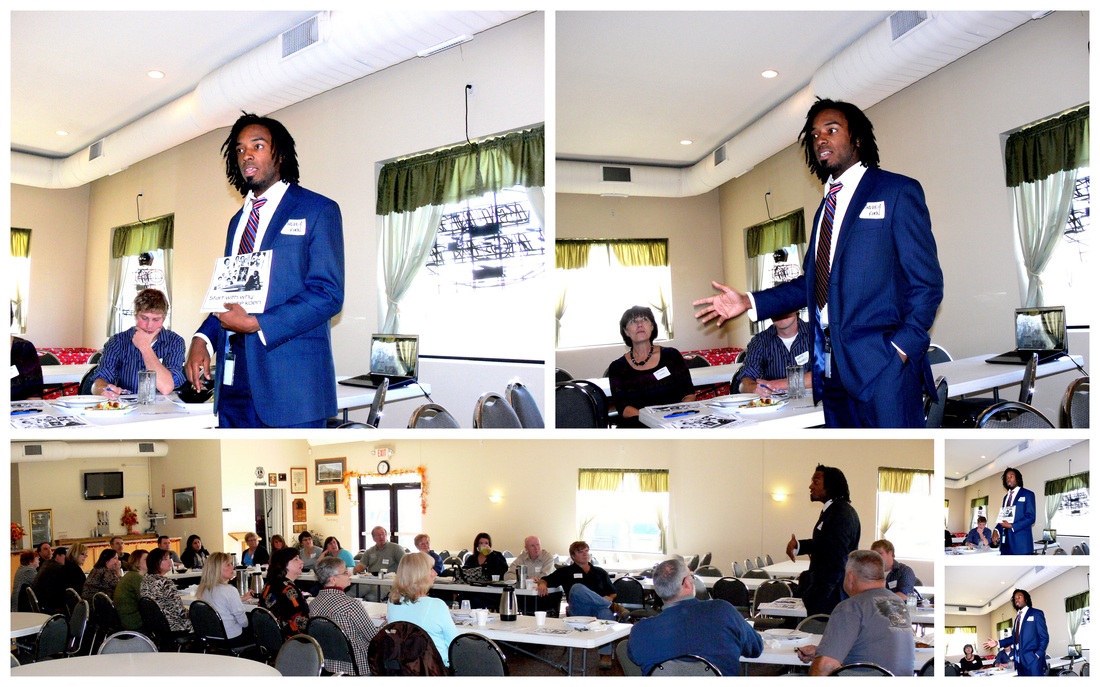|
| ||||
|
Andre Koen is a highly skilled community leader, public speaker, mentor, and activist. He has become well known for his highly acclaimed creation of innovative and behavioral changing courses, both for the classroom and online learning. This unique curriculum includes diversity education, cross-cultural competence, sensitivity training and team building. Additionally, Koen has extensive experience in educating others regarding anti-racism by sharing skills
that diffuse tense or stressful situations, which can arise in anyone’s personal or professional life. As the son of a Black Panther-turned-preacher, Andre learned at an early age the importance of reaching across cultural lines to seek understanding and acceptance. He also garnered this message from his mother, a highly compassionate special education teacher who taught Andre that each person has something worthwhile to offer. The lessons that Andre absorbed during his upbringing were further supported by receiving degrees in organizational leadership and educational technology. This combination of experience and training allowed Andre to become an effective manager, an understanding and compassionate leader, and a confident creator of change. He has received many awards and honors during his career including being named "Human Rights Worker of the Year" by the National Association of Human Rights", and the "American Red Cross Marketing and Community Presentations Volunteer of the Year" award. Andre is also highly proficient with technology and writes a weekly blog that disseminates ideas on fighting and removing discrimination. See his videos and learn more about creating change and making the world a better place at http://www.andrekoen.com/. |
Recycling minds in Anoka County
Andre Koen, the son of a Black Panther-turned-preacher, was talking about people reinventing themselves. He recalled a confrontation with a stranger who assaulted him with a racial slur. Koen is the Anoka County cultural coordinator and a motivational speaker whose clients have included the Minnesota Trial Lawyers Association, the Centennial Lakes School District and the New York Knicks. Intelligent and savvy, Koen has dealt with all kinds -- including a chicken farmer, whose beet-red face, alcohol-scented breath and struggle to maintain any semblance of balance suggested he'd strayed beyond his limit. The farmer told Koen he didn't like black people -- only, Koen recalled, the man didn't say it that politely. Koen, 39, is a tall, angular man with dreadlocks, a disarming smile and a simple philosophy: "We recycle minds." Instead of walking away or sparring verbally or physically with the farmer, Koen sat down with him. When their conversation was over, the farmer wrote his name and phone number on a napkin, handed it to Koen and told him to call if he ever needed chickens or fresh eggs. "Andre just defused a situation in our office an hour ago, with a woman and her son who walked in here expecting to get jobs," said Melanie Ault, Anoka County director of human services. "Andre stepped in and very clearly addressed the mother, then the son, and developed a rapport very quickly. "Other staff just watched and marveled. He has a way of turning awkward situations into very positive experiences." Koen has been honored by the National Association of Human Rights Workers as its Worker of the Year, and he has received the American Red Cross Marketing and Community Presentations Volunteer of the Year awards for community service. |
Recycling minds in Anoka County
- Article by: PAUL LEVY , Star Tribune
Koen's mother was a physical education teacher who worked with disabled kids. One of those children had no arms or legs. Koen said his mother's approach with the child could not have been more positive. He tries to bring that kind of compassion and "healthy nature" to his job... which is?
What exactly is a cultural coordinator?
Koen's predecessor, John Robinson, was known as the county's diversity director, after first being labeled the county's affirmative action officer. The title was going to be changed to "diversity coordinator," said County Administrator Terry Johnson, but former Commissioner Scott LeDoux wanted a more positive-sounding title, Johnson said.
But Koen defies labels.
"I don't have a rule book and I don't have a checklist," he said. "I'm trying to create new ways of having people think."
Absorbing it all
Long before earning a degree in organizational leadership from National American University and a master's degree in educational technology from the University of St. Thomas, Koen was nourished on religion, social consciousness and old-fashioned common sense.
When stories were told at relatives' funerals, young Andre walked away knowing who created recipes of his favorite dishes and who created recipes for adventure.
His grandparents met in Tennessee, and part of his family lived in Arkansas. He was told that when a great uncle mouthed off to a white woman, a stampede of white folks arrived at the uncle's door and told another relative, "We want him."
The family left Arkansas for Cincinnati and, later, Dayton, Ohio, which Koen describes as a "fabulous" place for a kid to be raised. But the family still had ties to Memphis -- there was a Koen cleaning business there -- and that only added to the shocking impression made on Koen's father when the Rev. Martin Luther King Jr. was assassinated there in 1968.
William Koen joined the Black Panthers, but he was still evolving.
"If we want change to happen, we have to have everybody at the table," Andre Koen said recently. "And my father knew it."
William Koen, an airport analyst, became a minister. He told his son that there are "no prescriptions for creating miracles." He was like many of Andre's other early mentors -- "so forward in thinking that everything I'm doing now is just catching up to where they were leaning."
Getting their attention
Andre considers his Anoka County work for the past five years his "dream job." But he was motivating groups and individuals years before -- as a paid facilitator, a teacher, even during his year as a member of Stevie Ray's Improvisational Comedy Troupe.
His website, at www.am horizons.com, emphasizes his ability to build teams and his work as a motivational speaker. But whether he's talking about self-worth, diversity or aging, Koen knows his audience.
"If I know people are here to see me because it's a mandatory training, the first thing I talk about is how much this training sucks," he said. "It doesn't suck, but I want to get their attention and I want them on my side."
He recently did a video demonstration that has been used by 17 counties and state agencies, he said. He's not afraid to wave his arms or raise his voice. When told how refreshing his videos are, he simply credits Anoka County for being diversified enough to go in different directions.
Teaching - and learning
His understanding of the Internet -- and of human nature -- make him stand out on the seventh floor of the Anoka County Government Center. And he remains as eager to learn as he is to teach.
At a conference, Koen met Chris Gardner, the self-made millionaire whose memoir, "The Pursuit of Happyness," is well known to movie- goers.
"I shook his hand and I felt the callouses and saw the cuts," Koen said. "I thought, 'Wow, this guy is the real deal.' That touched me."
Koen says he just wants to "contribute," to get people thinking about how they want to be, not just what they'd like to be.
"I just want to be part of the diversity," he said.
Paul Levy • 612-673-4419
Census reflects north metro changes By MARIA ELENA BACA, Star Tribune
Census reflects north metro changes By MARIA ELENA BACA, Star Tribune
March 29, 2011
In Columbia Heights, the changes are writ large on the storefronts.
Central Avenue through the city is home to Middle Eastern restaurants, Latin groceries, a Hmong-owned insurance agency, African-American hair salons, a Sharia real estate agency and more.
"We are moving from a metropolitan area to a cosmopolitan area," said Community Development Director Scott Clark. "This is part of the natural growth of an urban area."
As elsewhere in the Twin Cities metro area, growth in minority populations looms large in new U.S. Census data for the northern suburbs. In Columbia Heights, for example, although the city's population grew by only 5.3 percent in the past decade, to 19,496, the minority count rose 153 percent and is now 30 percent of the total.
Following the trend set by the northern suburbs closest to Minneapolis, Crystal's minority population grew 87 percent and Brooklyn Center's and Brooklyn Park's rose by 78 and 67 percent, respectively. Brooklyn Center, population 30,104, is now 50.9 percent minority, while Brooklyn Park, 67,388, is 47.6 percent. At the same time, on the northern reaches of the seven-county metro area, St. Francis' minority population fell from 4.3 to 4.1 percent, despite explosive growth of 47 percent overall, to 7,200. In the center of the county, Andover's minority population doubled, but people of color account for only 6.8 percent of the city of 30,600.
Andre Koen is cultural coordinator for Anoka County, which comprises much of the northern metro. He believes that the county's minority growth in particular can be traced to availability of amenities and services such as mass transit, affordable housing and jobs.
"You can't have one without having all of them, and I'm not sure how you build all of them simultaneously," he said. "They are so intricately connected, to create equitable communities we have to figure out how to get that mix."
In Andover, noted City Administrator Jim Dickinson, most of the city's recent growth has been in "step-up" houses, possibly making the city less appealing to the newest generations of immigrants.
At the same time, Crystal, just up Interstate 94 from Minneapolis, may have it all.
"We have affordable, modest housing," said City Manager Anne Norris. "I think the combination of location and cost of housing stock and type of housing stock makes it an attractive place to live."
But like other rapidly changing cities, Crystal is trying to figure out how to be inclusive of all residents. Officials are looking to neighboring cities for guidance, Norris said. There are plans to pick up New Hope's Know Your Neighbor community dialogues, for example.
"We recognize the face of Crystal is changing," she said. "We just haven't figured out how to be more inclusive."
Across the north metro, cities are in different stages of preparing to meet changing demographics.
Brooklyn Center and Brooklyn Park, which even 10 years ago had relatively high minority populations for the north metro, have worked to incorporate native-born and immigrant people of color into the daily operations of their cities, from the police departments to the city commissions that help set the tone of each city.
"We're probably more of an American city than any other city in Minnesota. ... Progressive people come here for that whole American dream," said Vickie Schleuning, Brooklyn Center's assistant city manager.
In Brooklyn Park, officials have worked hard to increase the percentage of people of color from 14 to 32 percent of the city's volunteer commission members. One effective approach was to invite leaders of ethnic groups to join, overcoming a cultural reluctance to step forward, said Denise Rene Wollenburg, the city's community outreach coordinator.
The next step may be bringing the majority culture on board, Koen said, noting that government types may not always be on the same page as long-term majority residents.
"As I get older, I realize the value of moving quickly, as well as making sure we are bringing people along," he said.
Staff writer Paul Levy contributed to this report. Maria Elena Baca • 612-673-4409
© 2012 Star Tribune. All rights reserved.
March 29, 2011
In Columbia Heights, the changes are writ large on the storefronts.
Central Avenue through the city is home to Middle Eastern restaurants, Latin groceries, a Hmong-owned insurance agency, African-American hair salons, a Sharia real estate agency and more.
"We are moving from a metropolitan area to a cosmopolitan area," said Community Development Director Scott Clark. "This is part of the natural growth of an urban area."
As elsewhere in the Twin Cities metro area, growth in minority populations looms large in new U.S. Census data for the northern suburbs. In Columbia Heights, for example, although the city's population grew by only 5.3 percent in the past decade, to 19,496, the minority count rose 153 percent and is now 30 percent of the total.
Following the trend set by the northern suburbs closest to Minneapolis, Crystal's minority population grew 87 percent and Brooklyn Center's and Brooklyn Park's rose by 78 and 67 percent, respectively. Brooklyn Center, population 30,104, is now 50.9 percent minority, while Brooklyn Park, 67,388, is 47.6 percent. At the same time, on the northern reaches of the seven-county metro area, St. Francis' minority population fell from 4.3 to 4.1 percent, despite explosive growth of 47 percent overall, to 7,200. In the center of the county, Andover's minority population doubled, but people of color account for only 6.8 percent of the city of 30,600.
Andre Koen is cultural coordinator for Anoka County, which comprises much of the northern metro. He believes that the county's minority growth in particular can be traced to availability of amenities and services such as mass transit, affordable housing and jobs.
"You can't have one without having all of them, and I'm not sure how you build all of them simultaneously," he said. "They are so intricately connected, to create equitable communities we have to figure out how to get that mix."
In Andover, noted City Administrator Jim Dickinson, most of the city's recent growth has been in "step-up" houses, possibly making the city less appealing to the newest generations of immigrants.
At the same time, Crystal, just up Interstate 94 from Minneapolis, may have it all.
"We have affordable, modest housing," said City Manager Anne Norris. "I think the combination of location and cost of housing stock and type of housing stock makes it an attractive place to live."
But like other rapidly changing cities, Crystal is trying to figure out how to be inclusive of all residents. Officials are looking to neighboring cities for guidance, Norris said. There are plans to pick up New Hope's Know Your Neighbor community dialogues, for example.
"We recognize the face of Crystal is changing," she said. "We just haven't figured out how to be more inclusive."
Across the north metro, cities are in different stages of preparing to meet changing demographics.
Brooklyn Center and Brooklyn Park, which even 10 years ago had relatively high minority populations for the north metro, have worked to incorporate native-born and immigrant people of color into the daily operations of their cities, from the police departments to the city commissions that help set the tone of each city.
"We're probably more of an American city than any other city in Minnesota. ... Progressive people come here for that whole American dream," said Vickie Schleuning, Brooklyn Center's assistant city manager.
In Brooklyn Park, officials have worked hard to increase the percentage of people of color from 14 to 32 percent of the city's volunteer commission members. One effective approach was to invite leaders of ethnic groups to join, overcoming a cultural reluctance to step forward, said Denise Rene Wollenburg, the city's community outreach coordinator.
The next step may be bringing the majority culture on board, Koen said, noting that government types may not always be on the same page as long-term majority residents.
"As I get older, I realize the value of moving quickly, as well as making sure we are bringing people along," he said.
Staff writer Paul Levy contributed to this report. Maria Elena Baca • 612-673-4409
© 2012 Star Tribune. All rights reserved.







